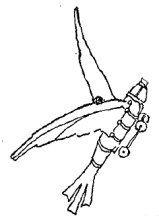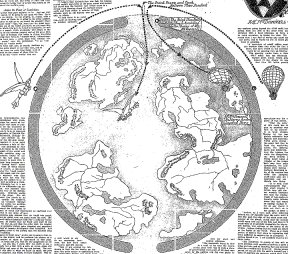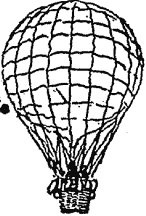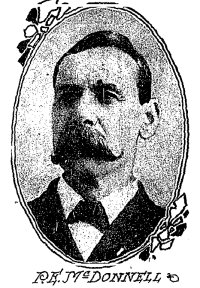
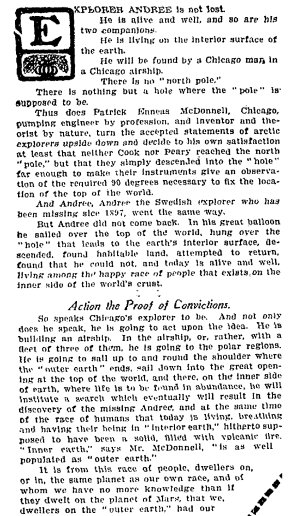
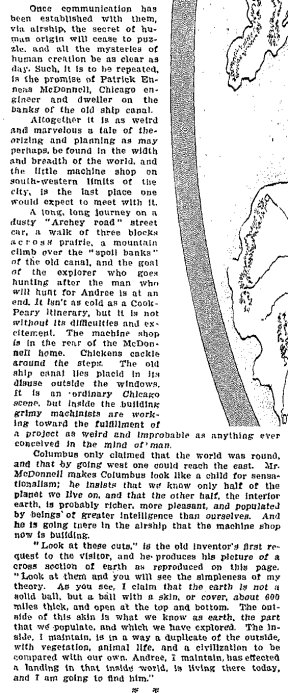
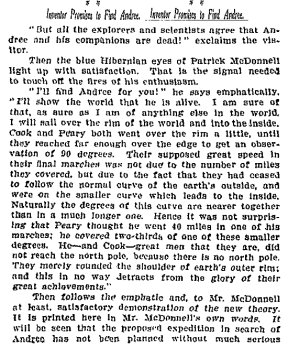
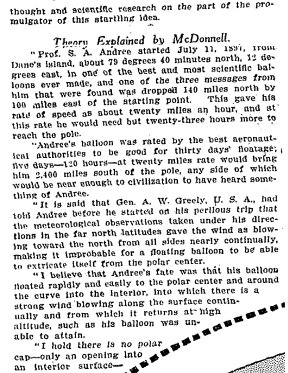
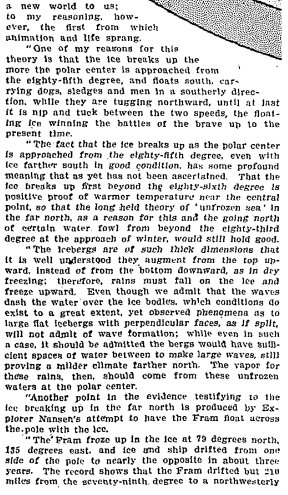

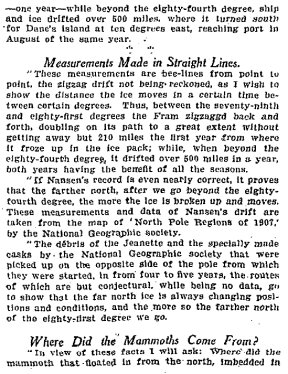
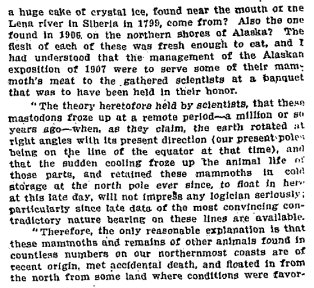
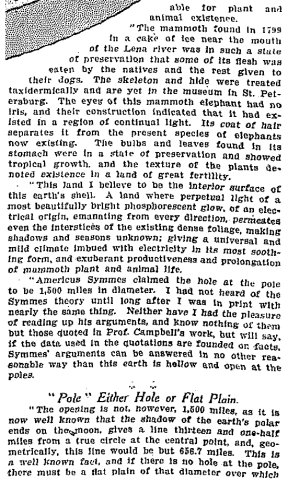
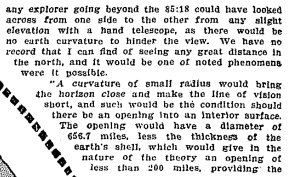
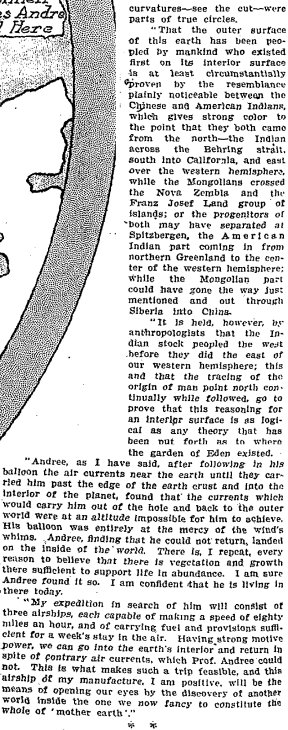
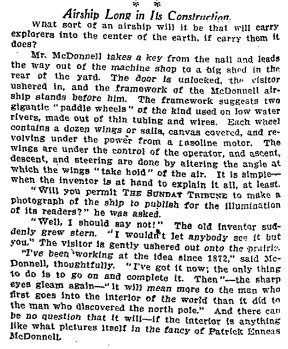
|
Explorer Andree is not lost.
He is alive and well, and so are his two companions.
He is living on the interior surface of the earth.
He will be found by a Chicago man in a Chicago airship.
There is no "north pole."
There is nothing but a hole where the "pole" is supposed to be.
Thus does Patrick Enneas McDonnell, Chicago, pumping engineer by profession
and inventor and theorist b nature, turn the accepted statements of arctic
explorers upside down and decide in his own satisfaction at least that
neither Cook nor Peary reached the north "pole," but that they simply descended
into the "hole" far enough to make their instruments give an observation
of the required 90 degrees necessary to fix the location of the tope of
the world.
And Andree, Andree the Swedish explorer who has been missing since 1897,
went the same way.
But Andree did not come back. In his great balloon he sailed over the
top of the world, hung over the "hole" that leads to the earth's interior
surface, descended, found habitable land, attempted to return, found that
they could not, and today is alive and well, living among the happy race
of people that exists on the inner side of the world's crust.
ACTION THE PROOF OF CONVICTIONS
So speaks Chicago's explorer to be. And not only does he speak, he
is going to act upon the idea. He is building an airship. In the airship,
or, rather , with a fleet of three of them, he is going to he polar regions.
He is going to sail up to and round the shoulder when the "outer earth"
ends, sail down into the great opening at the top of the world, and there,
on the inner side of earth, where life is to be found in abundance, he
will institute a search which eventually will result in the discovery of
the missing Andree, and at the same time of the race of humans that today
is living, breathing and having their being in "interior earth," hitherto
supposed to have been a solid, filled with volcanic fire "Inner earth,"
says Mr. McDonnell, "is as well populated as "outer earth."
It is from this race of people, dwellers on, or in, the same planet
as our own race, and of whom we have no more knowledge than if they dwelt
on the planet Mars, that we, dwellers on the "outer earth," and our origin!
Once communication has been established with them, via airship, the
secret of human origin will cease to puzzle, and all the mysteries of human
creation be as clear as day. Such, it is to be repeated, is the promise
of Patrick Enneas McDonnell, Chicago engineer and dweller on the banks
of the old ship canal.
Altogether it is as weird and marvelous a tale of theorizing and planning
as may perhaps, be found in the width and breadth of the world, and the
little machine shop on south-western limits of the city is the last place
one would expect to meet with it.
A long, long journey on a dusty "Archery road" street car, a walk of
three blocks across a prairie, a mountain climb over the "spoil banks"
of the old canal, and the goal of the explorer who goes hunting after the
man who will hunt for Andree is at an end. It isn't as cold as Cook-Peary
itinerary, but it is not without its difficulties and excitement. The machine
shop is in the rear of the McDonnell home. Chickens cackle around the steps
The old ship canal lies placid in its disuse outside the windows. It is
an ordinary Chicago scene, but inside the building grimy machinists are
working toward the fulfillment of a project as weird and improbable as
anything ever conceived in the mind of man.
Columbus only claimed that the world was round, and that by going west
one could reach the east. Mr. McDonnell makes Columbus look like a child
for sensationalism; he insists that we know only half of the planet we
live on, and that the other half, the interior earth, is probably richer,
more pleasant, and populated by beings of greater intelligence than ourselves.
And he is going there in the airship that the machine shop now is building.
"Look at these cuts," is the old inventor's first request to the visitor,
and he produces his picture of a cross section of earth as reproduced on
this page. "look at them and you will see the simpleness of my theory.
As you see, I claim that the earth is not a solid ball, but a ball with
a skin, or cover, about 600 miles thick, and open at the top and bottom.
The outside of this skin is what we know as earth, the part that we populate,
and which we have explored. The inside, I maintain, is in a way a duplicate
of the outside, with vegetation, animal life, and a civilization to be
compared with our own. Andree, I maintain, has effected a landing in that
inside world, is living there today, and I am going to find him."
INVENTOR PROMISES TO FIND ANDREE
"But all the explorers and scientists agree that Andree and his companions
are dead!" exclaims the visitor.
Then the blue Hiberian eyes of Patrick McDonnell light up with satisfaction.
That is the signal needed to touch off the fires of his enthusiasm.
"I'll find Andree for you!" he says emphatically. "I'll show the world
that he is alive. I am sure of that, as sure as I am of anything else in
the world. I will sail over the rim of the world and into the inside. Cook
and Peary both went over the rim a little, until they reached far enough
over the edge to get an observation of 90 degrees. Their supposed great
speed in their final marches was not due to the number of miles they covered,
but due to the fact that they had ceased to follow the normal curve of
the earth's outside, and were on the smaller curve which leads to the inside.
Naturally the degrees of this curve are nearer together than in a much
longer one. Hence it ws not surprising that Peary thought he went 40 miles
in one of his marches; he covered two-thirds of one of these smaller degrees.
He -- and Cook -- great men that they are, did not reach the north pole,
because there is no north pole. They merely rounded the shoulder of earth's
outer rim; and this is in no way detracts from the glory of their great
achievements."
Then follows the emphatic and, to Mr. McDonnell at least, satisfactory
demonstration of the new theory. It is printed here in Mr. McDonnell's
own words. It will be seen that the proposed expedition in search of Andree
has not been planned without much serious thought and scientific research
on the part of the promulgator of this startling idea.
THEORY EXPLAINED BY McDONNELL
"Prof. S. A. Andree started July 11, 1897, from Dan's island, about
79 degrees 40 minutes north, 12 degrees east, in one of the best and most
scientific balloons ever made, and one of the three messages from him that
were found was dropped 140 miles north by 100 miles east of the starting
point. This gave his rate of speed as about twenty miles an hour, and at
this rate he would need but twenty-three hours more to reach the pole.
"Andrees's balloon was rated by the best aeronautical authorities to
be good for thirty days floatage; five days -- 120 hours -- at twenty miles
rate would bring him 2,400 miles south of the pole, any side of which would
be near enough to civilization to have heard something of Andree.
"It is said that Gen. A. W. Greely, U.S.A., had told Andree before he
started on his perilous trip that the meteorological observations taken
under his directions in the far north latitudes gave the wind as blowing
toward the north from all sides nearly continually, making it improbable
for a floating balloon to be able to extricate itself from the polar center.
"I believe that Andree's fate was that his balloon floated rapidly and
easily to the polar center and around the curve into the interior, into
which there is a strong wind blowing along the surface continually and
from which it returns at high altitude, such as his balloon was unable
to attain.
"I hold there is no polar cap -- only an opening into an interior surface
-- a new world to us; to my reasoning, however, the first from which animation
and life sprang.
"One of my reasons for this theory is that the ice breaks up the more
the polar center is approached from the eighty-fifth degree, and floats
south, carrying dogs, sledges and men in a southerly direction. While they
are tugging northward, until at last it is nip and tuck between the two
speeds, the floating ice winning the battles of the brave up to the present
time.
"The fact that the ice breaks up as the polar center is approached from
the eighty-fifth degree, even with ice farther south in good condition,
has some profound meaning that as yet has not been ascertained. That the
ice breaks up first beyond the eighty-sixth degree is positive proof of
warmer temperature near the central point, so that the long held theory
of 'unfrozen sea' in the far north, as a reason for this and the going
north of certain water fowl from beyond the eighty-third degree at the
approach of winter, would still hold good.
"The icebergs are of such thick dimensions that it is well understood
they augment from the top upward, instead of from the bottom downward,
as in dry freezing;
therefore, rains must fall on the ice and freeze upward. Even though
we admit that the waves dash the water over the ice bodies , which conditions
do exist to a great extent, yet observed phenomena as to large flat icebergs
with perpendicular faces, as if split, will not admit of wave formation;
while even in such a case, it should be admitted the bergs would have sufficient
spaces of water between to make large waves, still proving a milder climate
farther north. The vapor for these rains, then, should come from these
unfrozen waters at the polar center.
"Another point in the evidence testifying to the ice breaking up in
the far north is produced by Explorer Nansen's attempt to have the Fram
float across the pole with the ice.
"The Fram froze up in the ice at 79 degrees north, 135 degrees east,
and ice and ship drifted from one side of the pole to nearly the opposite
in about three years. The record shows that the Fram drifted but 210 miles
from the seventy-ninth degree to a northwesterly point about the eighty-first
degree, from Sept. 22, 1893, to Oct. 1, 1894, nearly a year; while from
Oct 1, 1894, to Dec. 25, 1894, about three months, it drifted from the
eighty-first degree to 83.24 -- still northwesterly -- 250 miles. Again,
from Dec. 25, 1894 -- four months -- it drifted 75 miles north by west
and beyond the eighty-fourth degree, where Nansen, leaving the ship, made
his dash for the pole. But from May 1, 1895, to April, 1896 -- one year
-- while beyond the eighty-fourth degree, ship and ice drifted over 500
miles, where it turned south for Dane's island at ten degrees east, reaching
port in August of the same year.
MEASUREMENTS MADE IN STRAIGHT LINES
"These measurements are bee-lines from point to point, the zigzag drift
not being reckoned as I wish to show the distance the ice moves in a certain
time between certain degrees. Thus, between the seventy-ninth and eighty-first
degrees the Fram zigzagged back and forth, doubling on its path to a great
extent without getting away but 210 miles the first year from where it
froze up in the ice pack; while, when beyond the eighty-fourth degree,
it drifted over 500 miles in year, both years having the benefit of all
the seasons.
"If Nansen's record is even nearly correct, it proves that the farther
north, after we go beyond the eighty-fourth degree, the more the ice is
broken up and moves. These measurements and data of Nansen's drift are
taken from the map of 'North Pole Regions of 1907,' by the National Geographic
Society.
"The debris of the Jennette and the specially made casks by the National
Geographic society that were picked up on the opposite side of the pole
from which they were started, in from four to five years, the routes of
which are but conjectural, while being no data, go to show that the far
north ice is always changing positions and conditions, and the more so
the farther north of the eighty-first degree we go."
WHERE DID THE MAMMOTHS COME FROM?
"In view of these facts I will ask; Where did the mammoth that floated
in from the north, imbedded in a huge cake of crystal ice, found near the
mouth of the Lena river in Siberia in 1799, come from? Also the one found
in 1906 on the northern shores of Alaska? The flesh of each of these was
fresh enough to eat, and I had understood that the management of the Alaskan
exposition of 1907 were to serve some of their mammoth's meat to the gathered
scientists at a banquet that was to have been held in their honor.
"The theory heretofore held by scientists, that these mastodons froze
up at a remote period -- a million or so years ago -- when, s they claim,
the earth rotated at right angles with its present direction (our present
poles being on the line of the the equator at that time), and that the
sudden cooling froze up the animal life of those parts, and retained these
mammoths in cold storage at the north pole ever since, to float in here
at this late day, will not impress any logician seriously; particularly
since late data of the most convincing contradictory nature bearing on
these lines are available.
"Therefore, the only reasonable explanation is that these mammoths and
remains of other animals found in countless numbers on our northernmost
coasts are of recent origin, met accidental death, and floated in from
the north from some land where conditions were favor-able for plant and
animal existence. "The mammoth found in 1799 in a cake of ice near the
mouth of the Lena river was in such a state of preservation that some of
its flesh was eaten by the natives and the rest given to their dogs. The
skeleton and hide were treated taxidermically and are yet in the museum
in St. Petersburg. The eyes of this mammoth elephant had no iris, and their
construction indicated that it had existed in a region of continual light.
Its coat of hair separates it form the present species of elephants now
existing. The bulbs and leaves found in its stomach were in a state of
preservation and showed tropical growth, and the texture of the plants
denoted existence in a land of great fertility.
"This land I believe to be the interior surface of this earth's shell.
A land where perpetual light of a most beautifully bright phosphorescent
glow, of an electrical origin, emanating from every direction, permeates
even the interstices of the existing dense foliage, making shadows and
seasons unknown; giving a universal and mild climate imbued with electricity
in its mos soothing form, and exuberant productiveness and prolongation
of mammoth plant and animal life.
"Americus Symmes claimed the hole at the pole to be 1,500 miles in diameter.
I had not heard of the Symmes theory until long after I was print with
nearly the same thing. Neither have I had the pleasure of reading up his
arguments, and know noting of them but those quoted in Prof. Campbell's
work, but will say, if the data used in the quotations are founded on facts,
Symmes' arguments can be answered in no other reasonable way than this
earth is hollow and open at the poles.
"POLE" EITHER HOLE OR FLAT PLAIN
"The opening is not, however, 1,500 miles, as it is now well known
that the shadow of the earth's polar ends on the moon, gives a line thirteen
and one-half miles from a true circle at the central point, and, geometrically,
this line would be but 656.7 miles. This is a well known fact, and if there
is no hole at the pole there must be a flat plain of that diameter over
which any explorer going beyond the 84:18 could have looked across from
one side to the other from any slight elevation with a hand telescope,
as there would be no earth curvature to hinder the view. We have no record
that I can find of seeing any great distance in the north, and it would
be one of noted phenomena were it possible.
"A curvature of small radius would bring the horizon close and make
the line of vision short, and such would be the condition should there
be an opening into an interior surface. The opening would have a diameter
of 656.7 miles, less the thickness of the earth's shell, which would give
in the nature of the theory an opening of less than 200 miles, providing
the curvatures -- see the cut -- were parts of true circles.
"That the outer surface of this earth has been peopled by mankind who
existed first on its interior surface is at least circumstantially proven
by the resemblance plainly noticeable between the Chinese and American
Indians, which gives strong color to the point that they both came from
the north -- the Indian across the Behring strait, south into California,
and east over the western hemisphere, while the Mongolians crossed the
Nova Zembia and the Franz Josef Land group of islands; or the progenitors
of both may have separated at Spitzbergen, the American Indian part coming
in from northern Greenland to the center of the western hemisphere; while
the Mongolian part could have gone the way just mentioned and out through
Siberia into China.
"It is held, however, by anthropologists that the Indian stock peopled
the west before they did the east of our western hemisphere; this and that
the tracing of the origin of man point north continually while followed
go to prove that this reasoning for an interior surface is as logical as
any theory that has been put forth as to where the garden of Eden existed.
"Andree, as I have said, after following in his balloon the air currents
near the earth until they carried him past the edge of the earth crust
and into the interior of the planet, found that the currents which would
carry him out of the hole and back to the outer world were at an altitude
impossible for him to achieve. His balloon was entirely at the mercy of
the wind's whims. Andree, finding that he could not return, landed on the
inside of the world. There is, I repeat, every reason to believe that there
is vegetation and growth there sufficient to support life in abundance.
I am sure Andree found it so. I am confident that he is living in there
today.
"My expedition in search of him will consist of three airships, each
capable of making a speed of eighty miles an hour, and of carrying fuel
and provisions sufficient for a week 's stay in the air. Having strong
motive power, we can go into the earth's interior and return in spite
of contrary air currents, which Prof. Andree could not. This is what makes
such a trip feasible, and this airship of any manufacture, I am positive
, will be the means of opening our eyes by the discovery of another world
inside the one we now fancy to constitute the whole of 'mother earth'."
AIRSHIP LONG IN ITS CONSTRUCTION
What sort of airship will it be that will carry explorers into the
center of the earth, if carry them it does?
Mr. McDonnell takes a key from the nail and leads the way out of the
machine shop to a big shed in the rear of the yard. The door is unlocked,
the visitor ushered in, and the framework of the McDonnell airship stands
before him. The framework suggests two gigantic "paddle wheels" of the
kind used on low water rivers, made out of thin tubing and wires. Each
wheel contains a dozen wings or sails, canvas covered, and revolving under
the power from a gasoline motor. The wings are under the control of the
operator, and ascent, descent and steering are done by altering the angle
at which the wings "take hold" of the air. It is simple - when the inventor
is at hand to explain it all, at least.
"Will you permit THE SUNDAY TRIBUNE to make a photograph of the ship
to publish for the illumination of its readers?" he was asked.
"Well, I should say not!" The old inventor suddenly grew stern. "I wouldn't
let anybody see it but you." The visitor is gently ushered out onto the
prairie.
"I've been working at the idea since 1872," said McDonnell, thoughtfully.
"I've go it now; the only thing to do is to go on and complete it. Then"
-- the sharp eyes gleam again -- "it will mean more to the man who first
goes into the interior of the world than it did to the man who discovered
the north pole. And there can be no question that it will -- if the interior
is anything like what pictures itself to the fancy of Patrick Enneas McDonnell. |

